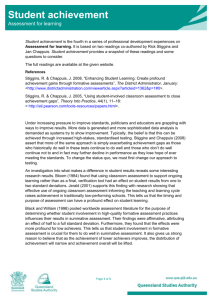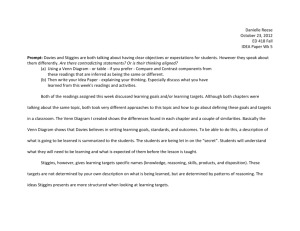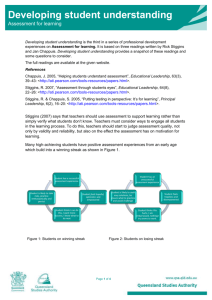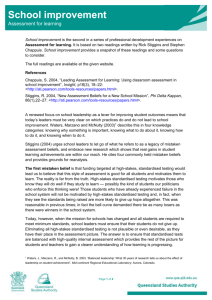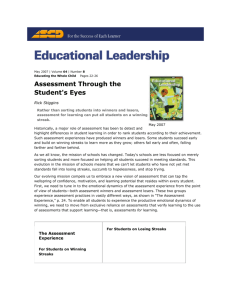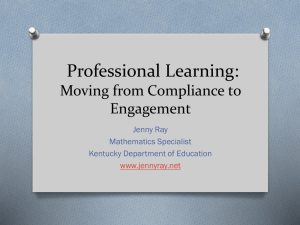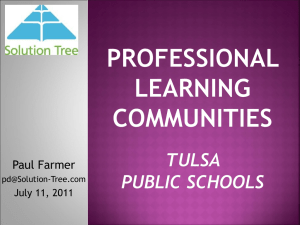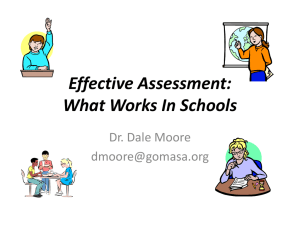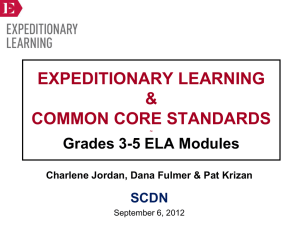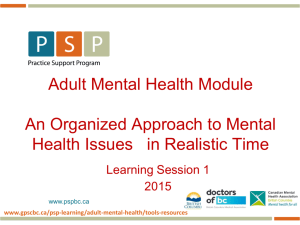Assessment for learning * A new perspective
advertisement
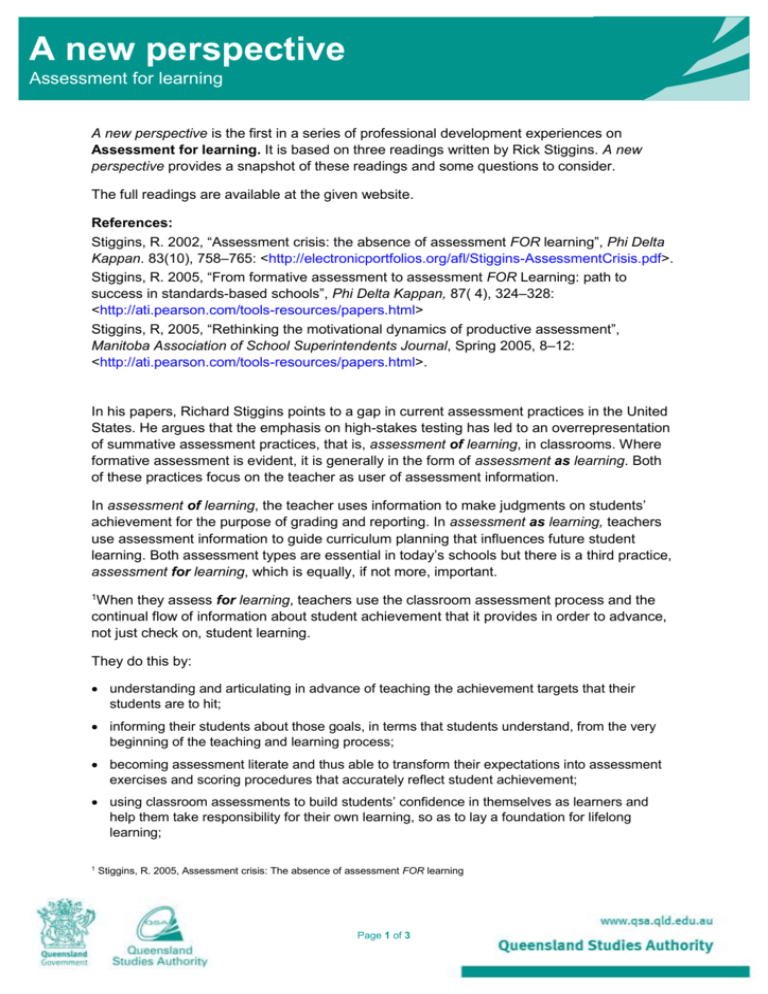
A new perspective Assessment for learning A new perspective is the first in a series of professional development experiences on Assessment for learning. It is based on three readings written by Rick Stiggins. A new perspective provides a snapshot of these readings and some questions to consider. The full readings are available at the given website. References: Stiggins, R. 2002, “Assessment crisis: the absence of assessment FOR learning”, Phi Delta Kappan. 83(10), 758–765: <http://electronicportfolios.org/afl/Stiggins-AssessmentCrisis.pdf>. Stiggins, R. 2005, “From formative assessment to assessment FOR Learning: path to success in standards-based schools”, Phi Delta Kappan, 87( 4), 324–328: <http://ati.pearson.com/tools-resources/papers.html> Stiggins, R, 2005, “Rethinking the motivational dynamics of productive assessment”, Manitoba Association of School Superintendents Journal, Spring 2005, 8–12: <http://ati.pearson.com/tools-resources/papers.html>. In his papers, Richard Stiggins points to a gap in current assessment practices in the United States. He argues that the emphasis on high-stakes testing has led to an overrepresentation of summative assessment practices, that is, assessment of learning, in classrooms. Where formative assessment is evident, it is generally in the form of assessment as learning. Both of these practices focus on the teacher as user of assessment information. In assessment of learning, the teacher uses information to make judgments on students’ achievement for the purpose of grading and reporting. In assessment as learning, teachers use assessment information to guide curriculum planning that influences future student learning. Both assessment types are essential in today’s schools but there is a third practice, assessment for learning, which is equally, if not more, important. 1 When they assess for learning, teachers use the classroom assessment process and the continual flow of information about student achievement that it provides in order to advance, not just check on, student learning. They do this by: understanding and articulating in advance of teaching the achievement targets that their students are to hit; informing their students about those goals, in terms that students understand, from the very beginning of the teaching and learning process; becoming assessment literate and thus able to transform their expectations into assessment exercises and scoring procedures that accurately reflect student achievement; using classroom assessments to build students’ confidence in themselves as learners and help them take responsibility for their own learning, so as to lay a foundation for lifelong learning; 1 Stiggins, R. 2005, Assessment crisis: The absence of assessment FOR learning Page 1 of 3 translating classroom assessment results into frequent descriptive feedback (versus judgemental feedback) for students, providing them with specific insights as to how to improve; continuously adjusting instruction based on the results of classroom assessments; engaging students in regular self-assessment, with standards held constant so that students can watch themselves grow over time and thus feel in charge of their own success; and actively involving students in communicating with their teacher and their families about their achievement status and improvement. A key difference in assessment for learning is that the student joins the teacher as a user of assessment information. This involvement enhances their control of the assessment environment improving motivation and success. The motivation of students is a vital contributor to performance. When a student is able to succeed, a student is usually motivated to continue to do well and thus approaches assessment with high expectations of success. When a student is unable to do well, a student becomes unmotivated and approaches assessment situations with low expectations of success and eventually hopelessness. So it is that high-stakes tests continue to motivate students who have always done well in tests and demotivate students who haven’t. The more high-stakes testing we place on students, the greater will be the achievement gaps between our highly motivated, high achievers and increasingly demotivated low achievers. This achievement gap has always been apparent, some learned a great deal in school and some very little; it hasn’t changed. What has changed is the social mission of schools. Schools in the past had a role of ranking students by achievement. Today’s schools still have that role but have also been given a new mission — a mission to ensure that all students achieve a minimum standard. This means that the achievement gap must be narrowed by raising the tail end. The way to do this, says Stiggins, is to involve students in the mission of their schooling. No longer is it acceptable for students to disengage and fail; they must be motivated, achievement-oriented participants in the learning and assessment processes. 2When principles of assessment for learning are applied consistently over time, unprecedented achievement gains result, for all students but especially for low achievers (Bloom 1984; Black and William 1998; Meisels, et. al. 2003; Rodriguez 2004). Students aren’t the only winners in a balanced model which values assessment for learning. Teachers also benefit in this system as they see success and the resulting enthusiasm for learning in their students. They benefit, too, from teaching time saved by using more efficient and accurate assessment practices to target learning needed by students and reduced behaviour management required for disengaged learners. Parents are rewarded by greater achievement and motivational levels in their children. School leaders benefit by meeting and exceeding public accountability requirements and achieving recognition for their school in doing so. Politicians also benefit by meeting and exceeding public accountability requirements. Assessment of learning already features heavily in classrooms; greater emphasis now needs to be placed on assessment as learning and particularly assessment for learning for Queensland schools to achieve their social mission. 2 2 | Stiggins, R. 2005, Rethinking the motivational dynamics of productive assessment A new perspective Assessment for learning Key ideas Definitions of assessment for learning, assessment as learning and assessment of learning. Similarities and differences between assessment of and for learning. The social mission of schools has changed from rank ordering students to requiring minimum standards for all students. A system that requires all students to achieve requires student input. Student motivation determines the level of input from students. Student motivation is directly influenced by the assessment practices of their teachers. Assessment practices directly impact upon student learning. High-stakes assessment motivates students who traditionally do well and demotivates students who haven’t experienced success. This exacerbates achievement differences between these groups of students. A balance of assessment practices is needed. Assessment for learning, assessment as learning and assessment of learning all have specific uses. Questions to consider: 1. What assessment balance is in your classroom? Draw up three columns heading each one with either assessment of learning, assessment as learning or assessment for learning. List your assessment items under each heading appropriately. What are your observations? 2. Who are the students in your class who might be in a demotivated/failure cycle? How could you assist them turn small successes into a cycle of success and high expectations? 3. How will an assessment for learning approach using the current curriculum support student learning? Queensland Studies Authority | 3
